
Excavations takes place to know about what happened in the unknown past of a place!
What was the reason behind the burning of the Nalanda University? Were there any Dinosaurs present in India? Was the Harappan and Mohanjodaro civilization as forward and sophisticated in their lifestyles as people of today are? If these are the questions that pop up in your mind, then visiting these excavated and archaeological place in India are surely going to cure some curiosity of yours.
India being one the oldest country in the world has got the remnants, which belong to the era of the Stone and Iron Age. If you are interested in exploring the lesser-known history of the world then check out the pre historic sites in India.
These tours include sightseeing of major archaeological sites and places and help you to get and insight of the old civilizations.
The sites below are representative of the places we can arrange for your tours. They are meant to serve as a source of inspiration for designing a custom tour that satisfies your particular needs and interests.
Hampi, Karnataka :Once considered"The best provided city in the world". Hampi was the capital of the powerful Vijayanagar empire, which for two centuries remained the most powerful empire in Indian history. It was considered at one time greater then Rome.
Konark Temples, Odisha: The great temple of Konark, is an enormous chariot of the Sun God, Surya, with 12 pairs of exquisitely carved wheels, drawn by galloping horses. A magnificent work of art, this temple is also known as the Black Pagoda.
Langudi, Odisha : An ancient Buddhist site in coastal Orissa along with an inscription referring to the great Mauryan emperor Ashoka.
Nalanda University, Bihar : Nalanda translates as 'the place that confers the lotus' or spiritual knowledge. A monastic university flourished here from the 5th to the 11th century. It is said to have contained nine million books, with 2,000 teachers to impart knowledge to 10,000 students who came from all over the Buddhist world.
Sanchi Stupas, M.P : More than any other monument, the Great Stupa of Sanchi symbolizes the rise and spread of Buddhism in India. It is also the largest site of Buddhist remains in India.
Kalibanga, Rajasthan : A site of delight for the archaeology enthusiasts, Kalibanga's archaeology dates back to the Harappan and pre-Harappan times.
Wood Fossil Park, Rajasthan : If you are interested in geology, visit the Wood Fossil Park that houses 180 million-year-old fossils that are the geological landmarks for the study of the Thar Desert.
Champaner Pavagadh Archeological Park : It is an assemblage of over 100 small and large monuments largely unexcavated and bearing archaeological, historic and living cultural heritage properties.
Dholavira, Gujarat : Another noteworthy Harappan site of Gujarat is Dholavira, locally known as Kotada, situated in the Khadir Island of Kuchchh. It is remarkable for its magnificent planning and enormity of area and deposit.
Lothal, Gujarat : Witness the relics and remnants of the Harappan era. The Harappan Culture in all its variant forms is well represented in Lothal.
Raivoli, Gujarat : Considered one of the three largest dinosaur sites in the world, Raivoli is worth a visit for those who are curious to know more about the pre-historic creature.
Kaushambi, Uttar Pradesh : Kaushambi was the capital of 'Vatsa Janpad' ruled by King Udyana, during the time of Buddha. The ruins of an ancient fort stand testimony to its ancient past. This is revered site where Lord Buddha is said to have attained 'Mahaparnirvana'.
Suketi Fossil Park, Himachal Pradesh : This park is first of its kind in Asia to be developed at the actual site where fossils and skeletons of pre-historic animals were discovered.






